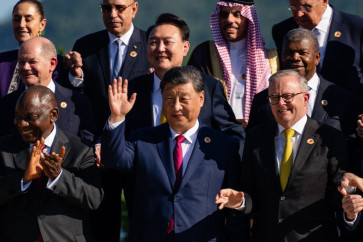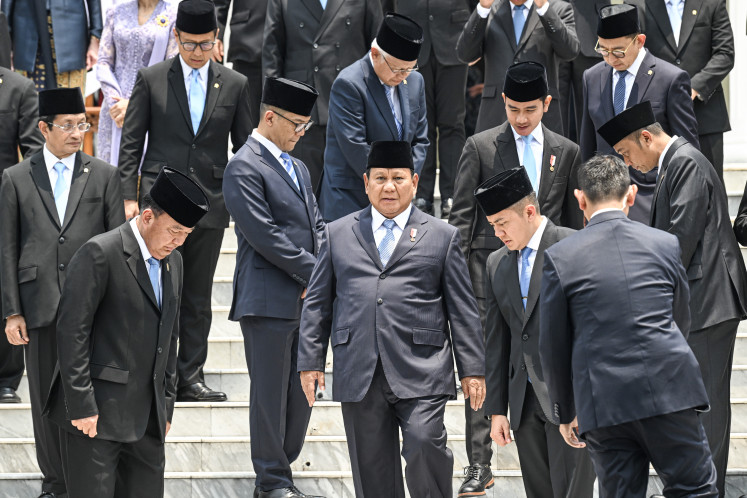Popular Reads
Top Results
Can't find what you're looking for?
View all search resultsPopular Reads
Top Results
Can't find what you're looking for?
View all search resultsARMA More than a museum
Grand entrance: Visitors stand at the entrance of the Agung Rai Museum of Art (ARMA) in Ubud, Bali
Change text size
Gift Premium Articles
to Anyone
Grand entrance: Visitors stand at the entrance of the Agung Rai Museum of Art (ARMA) in Ubud, Bali.
Agung Rai Museum of Art (ARMA) in Bali is gaining worldwide popularity, displaying various aspects of life from fine art, music, dance, drama, to nature.
In mid-August, Gung Rai or Agung Rai, 61, looked rather tired, sitting in the back yard of a Warung Kopi restaurant in the ARMA complex in Ubud, Bali.
He was exhausted after inspecting preparations for the Ubud Jazz Festival in the arena of ARMA to be held the next day, a big event featuring jazz musicians from Indonesia and other countries.
He had also given dance and gamelan training to dozens of children who would perform at ARMA within a few days and checked the completion of a new gallery, Rumah Gambar (painting house), as a display room for international painters.
“These were part of the activities to commemorate the 20th anniversary of ARMA this year,” explained Gung Rai, taking off his udheng (headgear).
Meanwhile, visitors to the museum were relaxing in its vast park with some reading brochures and others taking pictures of shrubberies and blooming flowers.
Many others were certainly in the building, observing traditional paintings by Balinese maestros from Ida Bagus Made Togog to Wayan Bendi and modern works by Balinese painters from Anak Agung Rai Kalam to Nyoman Erawan.
Those of Javanese and foreign artists were also there, from Affandi, Anton Kustia Widjaja, to Rolland Strasser.
“Hundreds of ARMA’s collections have inspired many researchers to write books. The latest one is Saraswati in Bali by Ron Jenkins, an expert from the Guggenheim Institution in the US,” Gung Rai said.
ARMA has become a major museum in Bali with its living museum concept that involves the environment and Bali’s cultural icons, which has earned ARMA recognition among art communities in the country, where its extra-large complex is just one indicator of its important status.
Gung Rai, whose full name is Anak Agung Gde Kurnia, was originally known as the owner of Agung Rai gallery, which was established in 1978.
In 1985, he went to Den Haag, the Netherlands, to accompany Nyoman Gunarsa for the latter’s solo exhibition.
During the visit, Gung Rai was astounded when he visited Kroller Muller Museum in Otterloo, a museum amid a forest only accessible by foot, bicycle or pollution-free vehicles.
In May 1989, Agung Rai Gallery held an exhibition in Tokyo, Japan, which received an overwhelming public response.
“Then I told my wife that we should start a social commitment to safeguard and preserve ancestral heritage. We should build a museum,” he said of ARMA’s beginnings.
His wife, Rai Suartini aka Gung Biang, nodded in agreement.
In 1990, he started to make his dream of having a museum into a reality. It was all started with a big idea. Gung Rai wished to have a museum that would not only display art collections but also create the atmosphere of Balinese people’s life, which is one with their nature and socio-cultural environment. The dream design covers a stretch of land as the location for art buildings, art studios, performance arenas, animal stakes, ox yokes, among others.
“I started with a plot of 9,000 square meters,” he said.
When he wished to expand the museum with its adjacent land, he had to provide a plot elsewhere four times as large as that he gained.
Gung Rai adopted this land acquisition method for many years until ARMA occupied an area of 60,000 sqm.
Under his acquisition ambition, he strived to expand the land to make three sides of the museum border on three pakraman villages (those with artistic potential), which have given birth to legendary painters, sculptors, dancers and musicians for generations.
Among these artists was Ketut Liyer (who died on June 10 at 92), a painter and healer depicted in the novel and film Eat, Pray, Love starring Julia Roberts.
Design-wise, ARMA follows the concept of Asta Kosala Kosali, Bali’s typical construction blueprint, which upholds the philosophy of tri angga.

Amid the images: A woman checks out artwork at the museum.
The philosophy divides life into three parts — utama angga (head), madya angga (torso) and nista angga (feet and reproductive organs). By adopting this philosophy into the museum design, it means whoever enters ARMA is like going through the order of life.
On their journey in the museum, visitors are taken to a farm with various local plants and fruit trees as well as medicinal herbs as part of the belief of the existence of life’s order in the museum.
There’s also teep (Artocarpus altilis), a big tree symbolizing the meeting of lingga (male) and yoni (female).
Interestingly, a number of those trees are labeled with photos and scientific notes, just like the plants at the Bogor Botanical Garden in Bogor, West Java.
ARMA also provides art, music, dance and painting training for children and preserve the potential of adult dancers (aged above 65).
It also holds discussions, seminars, workshops, art performances and painting auctions. Balinese’s sharing principles have become the spirit of ARMA’s activities.
“This museum is actually positioned as a cultural community in Bali,” said Gung Rai.
Gung Rai also explained that ARMA had received no financial aid from third parties.
“I have my own gallery, hotel and restaurant to subsidize the museum,” he added.
As a venue frequented by many important international conferences of culture, art and nature, ARMA is also studded with world luminaries.
Al Gore (former US vice president), Desmond Tutu (Nobel Peace laureate), Edgar Mitchell (US astronaut) and John Naisbitt (author of Megatrend 2000) have visited ARMA.
With worldwide connection and recognition, Gung Rai has also formed Friends of ARMA (FoA) in Japan, America and Canada.
— Photos by Agus Dermawan T

.img_assist_custom-512x399.jpg)








